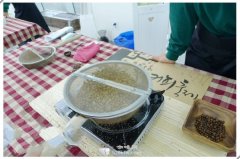On the concept and principle of Coffee Baking
As the name suggests, roasting is to provide heat to coffee beans, causing a series of chemical changes inside. Raw coffee beans show the unique color, aroma and taste of coffee by roasting. Every coffee bean contains fragrance, sour taste, sweet taste and bitter taste. How to release it incisively and vividly depends on the heat of baking.
From the insipid raw beans to the mellow aftertaste in the cup, baking is a very important step in the long journey of every coffee bean to outline its character and nurture its fragrance. Coffee beans are about 20 minutes long (inversely proportional to the temperature) and the temperature is as high as more than 200 degrees Celsius. In the process of dialogue with hot cuts, coffee beans have undergone many chemical changes. First of all, the starch in raw beans will be converted into sugars and acids because of high temperature, while substances such as cellulose will be carbonized to varying degrees. Water and carbon dioxide evaporate, while proteins are converted into enzymes, which combine with the rest of the fat to form an oil film on the surface of coffee beans. Coffee beans swell after roasting, giving off a primary explosion, a secondary explosion, a sound like popcorn, and loss of moisture. But because the skin on the surface of coffee beans is very tough, we usually don't see coffee beans crack like popcorn. From raw beans, light roasting, medium roasting to deep roasting, the water is released again and again, the weight is reduced, but the volume slowly expands, the color of the coffee beans deepens, the fragrant oil is gradually released, and the texture becomes crisp.
In raw beans, there is a lot of chloric acid, which gradually disappears with the baking process, releasing familiar and pleasant fruit acids, such as acetic acid, citric acid and malic acid in wine. Baking moderately presents these sour flavors.
We often see that roasted coffee beans have different shades of color. On the one hand, this may be due to different types of individual coffee beans; on the other hand, the main reason for this color difference is the degree of roasting. In the most popular language, the degree of baking can be interpreted as the heat of baking. Take the most classic example of carbonated coffee, a French roasted coffee that is highly carbonized, dark brown and carbon black due to its deep roasting (either because of the high temperature during baking, or because of the long baking time, or both, depending on the situation). It is generally believed that carbonized coffee tastes bitter, which comes not only from caffeine but also from carbonized coffee beans.
The principle of baking: the most important thing in baking is to be able to stir-fry the inside and outside of the beans evenly. First of all, the moisture in the beans will be discharged smoothly through firepower. If this step is too hasty, it will be spotted, and the taste will be astringent and choking.
80% of the taste of coffee depends on roasting, so roasting is an important process for brewing good coffee. If the baking technology is good, the beans will be large and swollen, with no wrinkles and luster. Roasting coffee beans into their ultimate characteristics is the ultimate goal of baking.
The flavor of coffee not only depends on the variety of coffee, roasting is also a decisive factor.
Basically, the roasting of coffee is a kind of high-temperature coking, which completely changes the substances inside the raw beans, produces new compounds, and recombines to form aroma and mellow flavor. This effect will only occur at high temperature. If only low temperature is used, it will not cause decomposition, and no matter how long it is roasted, coffee beans will not be cooked.
Important Notice :
前街咖啡 FrontStreet Coffee has moved to new addredd:
FrontStreet Coffee Address: 315,Donghua East Road,GuangZhou
Tel:020 38364473
- Prev

Complete knowledge of coffee roasting
Coffee roasting (coffee roasting) refers to the heating of raw beans to convert starch in raw beans into sugars and acids at high temperature, cellulose and other substances will be carbonized to varying degrees, water and carbon dioxide will be volatilized, proteins will be converted into enzymes and fats, and the remaining substances will be combined to form an oil film on the surface of coffee beans, and in the process coffee acids will be formed.
- Next

On the process and stage characteristics of coffee roasting
Most people think that baking is nothing, just frying the raw beans with fire. In fact, in the process of coffee processing, roasting is the most difficult step, it is a kind of science, but also an art, so in Europe and the United States, experienced roasters enjoy a highly respected status. Baking can be divided into the following three stages
Related
- Beginners will see the "Coffee pull flower" guide!
- What is the difference between ice blog purified milk and ordinary milk coffee?
- Why is the Philippines the largest producer of crops in Liberia?
- For coffee extraction, should the fine powder be retained?
- How does extracted espresso fill pressed powder? How much strength does it take to press the powder?
- How to make jasmine cold extract coffee? Is the jasmine + latte good?
- Will this little toy really make the coffee taste better? How does Lily Drip affect coffee extraction?
- Will the action of slapping the filter cup also affect coffee extraction?
- What's the difference between powder-to-water ratio and powder-to-liquid ratio?
- What is the Ethiopian local species? What does it have to do with Heirloom native species?

